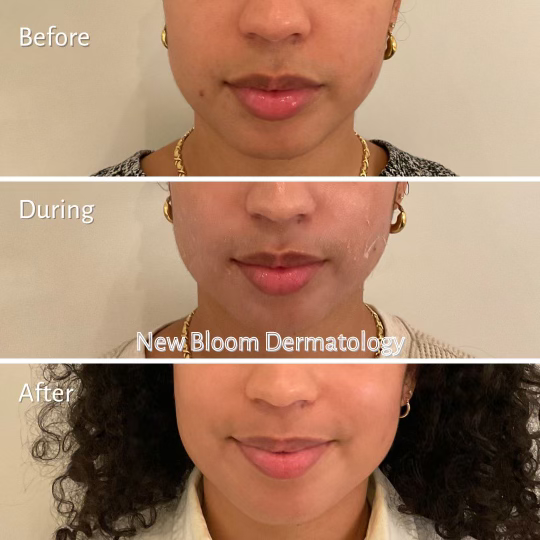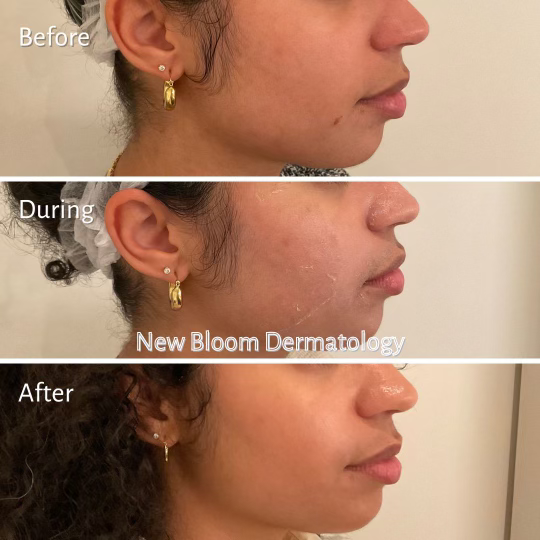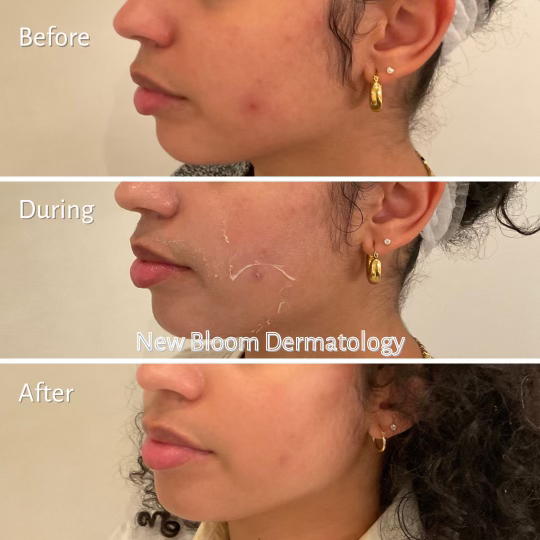Chemical Peels
What are Chemical Peels?
Chemical peels exfoliate the skin, revealing brightened and rejuvenated skin. New Bloom Dermatology offers peels with varying depths, from very light to medium. The very light peels provide a mild exfoliation and lightens superficial dark spots. These peels include a lower concentration alpha-hydroxy acid such as glycolic acid, beta-hydroxy acid such as salicylic acid, retinoic acid, and trichloroacetic acid. Higher concentrations of these peels, also known as light peels, regenerate and exfoliate the skin at a deeper level, lightens dark spots, removes precancerous cells, and mildly improves collagen density. Medium depth peels enable the exfoliation of sun damage, decrease dark marks, and increase collagen production. The deeper the peel, the greater the downtime required to recover from the procedure.
A series of salicylic acid peels has been successfully used to treat acne and acne scars. These peels bring blackheads or comedones to the surface and have a decreased risk of causing hyperpigmentation. It is advised these peels be done two weeks before a facial.
New Bloom Dermatology also offers Vi Peel, Vi Peel Precision Plus, and Vi Peel Purify Precision Plus. These medium depth peels combine trichloroacetic acid, retinoic acid, salicylic acid, phenol, and vitamin C to treat acne, acne scarring, age spots, post inflammatory hyperpigmentation (PIH), sun damage, and melasma. Skin exfoliation is enhanced with retinoic acid pads and a majority of the peeling is completed within five days. After removal of the top layer of the skin, the skin appears brighter, smoother, and rejuvenated. These peels are safe to use in all skin types.
How do Chemical Peels work?
Chemical peels react with the skin to exfoliate the upper layers of the skin. The depths vary depending on the strength and formulation of the peel. The peeling process also enables the lightening of dark spots from sun damage, melasma, and post inflammatory hyperpigmentation (PIH) and treatment of acne, as blackheads or comedones are brought to the surface. Deeper peels enable the exfoliation of sun damage and increase collagen production.



How do you prepare for a Chemical Peel?
Before a peel is performed, patients are advised to stop using topical retinoids, such as tretinoin (Retin A®), tazarotene (Tazorac®), and adapalene (Differin®), and any over-the-counter retinol five days before the procedure. Patients with a prior history of cold sores should inform the providers at New Bloom Dermatology of their history, as anti-viral medication can be prescribed to prevent cold sore breakouts as a result of the peel. Furthermore, patients should avoid sun exposure for four weeks before and after the peel is performed to prevent hyperpigmentation.
Who is a candidate for Chemical Peels? Who is not a candidate?
Patients who are seeking treatment for acne, acne scars, and hyperpigmentation from sun damage, post inflammatory hyperpigmentation, and melasma would benefit from chemical peels.
Patients who are pregnant, breastfeeding, have an allergy to aspirin, phenol, and salicylic acid should avoid chemical peels. Furthermore, patients with an active infection such as cold sores, impetigo, and warts should hold off on treatment. Patients who have been on accutane or isotretinoin should hold off on chemical peel treatment for six months after their last treatment.
What can you expect during a Chemical Peel?
After the face is cleansed, the chemical peel is applied, avoiding the eyes and mouth. Patients can experience burning and tingling, which subsides over a few minutes. In some cases, such as glycolic acid peels, the reaction is stopped with the application of a neutralizer. In other cases, cool compresses are applied. After the peel is completed, patients can experience frosting, redness, and swelling of the skin. Moisturizer and sunscreen are applied.
After the Vi Peel is applied on cleansed skin, patients are advised to leave on the peel for four hours. A burning sensation is expected, which subsides with the help of phenol
What are the side effects of Chemical Peels?
Side effects of a chemical peel include burning, tingling, redness, swelling, irritation, and frosting of the skin. These side effects subside over 48 to 72 hours. Patients who receive a Vi Peel will experience peeling 48 hours after treatment and a majority of the peeling subsides within five days of treatment. Picking of the skin should be avoided to prevent the risk of hyperpigmentation and scarring.
What are the aftercare instructions for Chemical Peels?
Patients are advised to constantly moisturize the peeling skin, use sunscreen, and avoid sun exposure. Patients who experience skin peeling are advised to avoid heavy sweating and use moisturizer and sunscreen to sweep the peeling skin away. Patients can also use facial scissors to cut the peeing skin and avoid picking the skin to prevent hyperpigmentation and scarring.
Patients who receive Vi Peel will receive a post-treatment kit which includes a recovery cream, sunscreen, and pads. They are to follow the post care instructions.
Patients are advised to hold off on harsh products, such as topical retinoids, salicylic and glycolic acid, and benzoyl peroxide until all peeling has subsided.
When will I notice results from Chemical Peels? How many treatments are needed?
Patients are advised to have three chemical peel treatments done every four weeks to treat acne, hyperpigmentation, and melasma. Full results can be seen four weeks after treatment.
What are the potential costs for Chemical Peels?
Please contact the office at (212) 207-0078 or info@newbloomderm.com for pricing.
Are there related procedures to Chemical Peels?
Chemical peels are best done two weeks before a customized facial. The chemical peels bring the blackheads or comedones to the surface and consequently, the facialist can easily extract these blackheads.